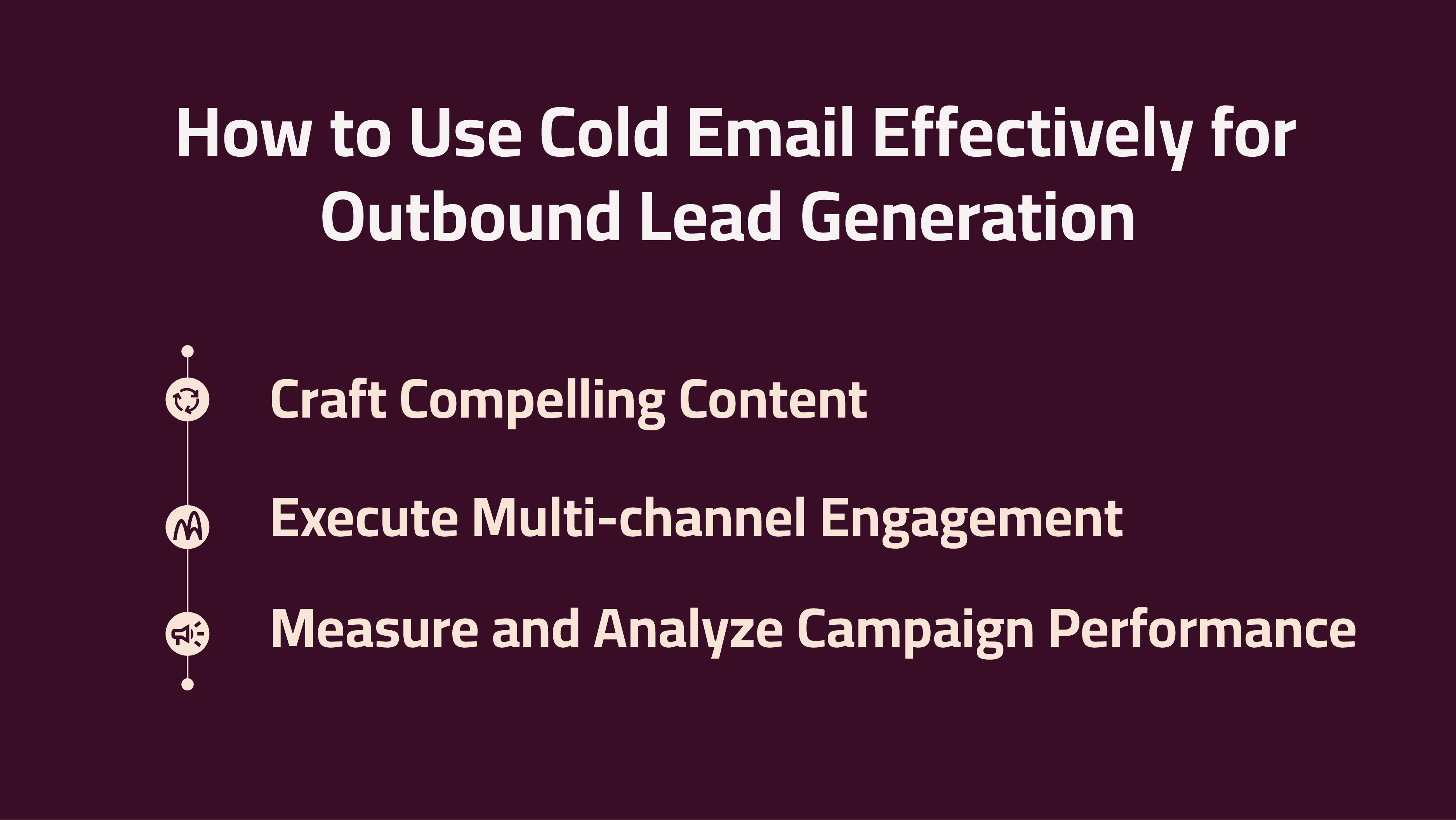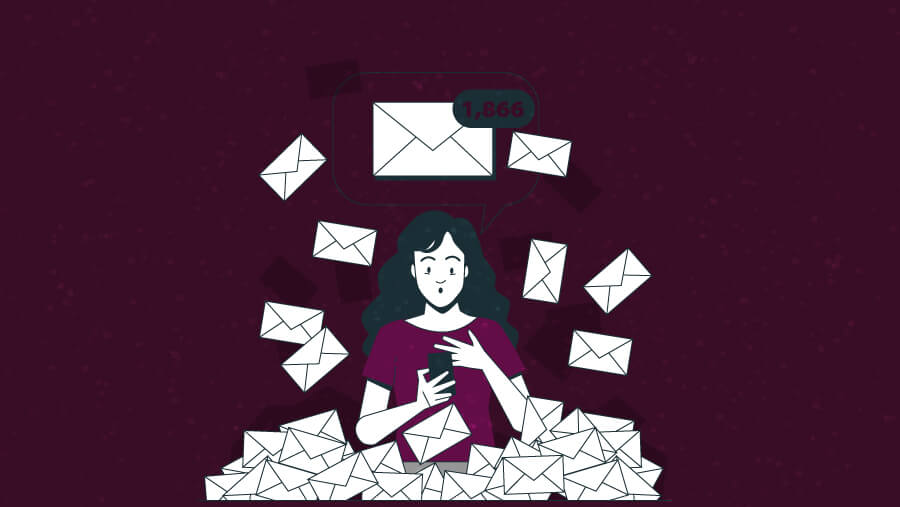
Unlock the Cold Email Goldmine: Outbound Lead Gen That WORKS!
59% of B2B marketers affirm that email is their most effective revenue-generating channel. 87% say it is one of their top free organic content distribution channels. Isn't that impressive?
Now, let’s put this into perspective for your business. In outbound lead generation, cold email is a tool that, when used effectively, can transform potential leads into valuable customers.
Cold emails serve as dynamic, personalized platforms that can:
- Tell your brand's story
- Showcase your value
- Engage prospects meaningfully
By leveraging cold email’s full potential, you connect, engage, and build relationships that could lead to significant business deals. More on this ahead.
How to Use Cold Email Effectively for Outbound Lead Generation

Let’s explore how to harness cold email's rich potential to enhance your outbound lead generation efforts.
1. Craft Compelling Content
Your emails MUST speak directly to your recipient and offer solutions they have been searching for. In short, drafting cold email content starts with understanding the psychology behind what makes target audiences click. Let’s explore this in detail:
A. Explore Copywriting Techniques
Good copywriting is like having meaningful conversations with your prospects. It's direct, personal, and engaging. Let’s see how you can make excellent copies:
- Start With a Subject Line that Hooks Your Reader
Personalizing the subject line can increase your email open rates by up to 50%.
For example, instead of a generic "Improve Your Sales Process," try "John, Boost Your Sales in 30 Days!" See the difference? It’s all about making the recipient feel like you’re speaking directly to them.
- Maintain Clarity in the Body
Next, your email body should continue the conversation started by the subject line. Use short, concise sentences to keep the reader’s attention. A study showed that emails with approximately 20 lines of text, or about 200 words, have the highest click-through rates.
For example, let’s say you're promoting a new product. Instead of diving straight into its features, narrate how it can solve a specific problem, making the reader’s life easier.
- Leverage Psychological Principles
Trigger the psyche of your readers by using elements like:
- Scarcity (“Limited offer!”)
- Social proof (“Join thousands of satisfied customers!”)
- Personalization (“Designed for your needs, John!”)
These elements make your content informative, persuasive, and relatable.
B. Master Storytelling Strategies
Stories can engage and persuade by forging a familiarity with the reader. When you narrate a story in your email, you're selling a product or service; true. But you’re also inviting the reader into a narrative where they can picture themselves benefiting.
- Utilize Storytelling to Create Emotional Connections
Incorporate real-life case studies or testimonials to add authenticity to your story. For instance, share a testimonial from a client who achieved remarkable results with your product. It can be more convincing than simply listing product features.
- Incorporate Storytelling Elements into Email Campaigns
Align these stories with your brand’s identity and values. This alignment builds your brand’s image in prospects' minds.
For example, if your brand values innovation, share stories of how your product has led to creative solutions for your customers.
C. Follow Formatting Best Practices
A cold email that’s easy on the eyes is more likely to be read. Formatting plays a crucial role in making your email readable and engaging. Here are a few tips:
- Use Visually Appealing and Mobile-Friendly Layouts
With over 55% to 65% of emails opened on mobile devices, it’s essential to design your emails to be mobile-friendly. Use a responsive design that adjusts to various screen sizes and ensures your content is easily scannable.
- Optimize Formatting for Improved Readability
- Utilize white space effectively to avoid clutter
- Use headings and bullet points to break up text
- Choose fonts and colors that reflect your brand and are easy to read
Tools like Litmus, Email on Acid, and Grammarly can help evaluate email formatting and readability, optimizing communication with your audience.
2. Execute Multi-channel Engagement
Consider your cold email campaigns the starting point of a multi-channel marketing journey. While essential, emails are just one part of a broader strategy. A cohesive approach across different marketing channels (direct mail, social outreach, and phone calls) can amplify your message and reach a wider audience.
-
Integrate Emails with Other Outbound Channels
Integrating your email campaigns with other outbound channels ensures a unified message resonates more strongly with your audience.
For instance, if your email mentions a new product launch, your LinkedIn outreach should echo this. You can also share behind-the-scenes content or customer testimonials via direct mail.
This integration creates a seamless customer experience and reinforces your message and brand across all platforms.
-
How to Execute Multi-channel Outreach
Use automation and Customer Relationship Management (CRM) tools to synchronize your campaigns. These tools can help track customer interactions across different channels, allowing for a consistent and timely communication strategy.
For example, after sending an initial email, follow up with a phone call – to address potential questions or concerns in the email.
1. Maximize Reach and Impact
You need to increase your reach to unlock the potential of your outbound campaigns. Here’s how:
- Leverage Audience Segmentation
Start by segregating your audience. It allows you to tailor your messaging to different groups, increasing relevance and engagement. For example, your email content for C-level executives should differ from that for mid-level managers.
- Coordinate Across Platforms
Consider a company that uses a playful tone in its emails but a formal tone in its LinkedIn InMails. This disparity can confuse customers and dilute the brand message.
As it’s evident, consistency is key. Your brand’s voice, message, and visual identity should be harmonious across all channels. It helps build brand recognition and trust.
3. Measure and Analyze Campaign Performance
Tracking your cold email campaigns’ key metrics is like having a roadmap for your marketing campaign. It shows you where you are and helps guide you where you want to be. Here are the steps to follow:
A. Track Key Metrics
Consider open rates, click-through rates (CTR), and conversion rates.
- An open rate is your first signal of success; it tells you how many people are opening your emails. But it's just the start.
- A healthy open rate means your subject lines work, but what next?
- This is where CTR shows you how many of those opened emails led to clicks on your links or calls to action.
- Finally, the conversion rate closes the loop, telling you how many clicks turned into business outcomes, such as sales or sign-ups.
Here’s an illustration:
Let’s say your open rate is high, but your CTR is low. Your email content might be less compelling than your subject line suggested.
Again, let’s assume your industry average for open rates is around 20%, but you’re consistently hitting 30%. That’s great, right? But if the industry CTR is 2.5% and you’re at 1%, there's room to improve how your content engages and drives action.
B. Learn Data Interpretation Strategies
Analyzing your email campaign data can provide deep insights into recipient behavior and preferences. It helps you understand the 'what' and the 'why' behind the numbers.
Segmenting your data based on different demographics or behaviors can reveal which groups are more engaged or likely to convert. For example, you might find that decision-makers in larger companies respond better to detailed case studies, while small business owners prefer quick, actionable tips.
C. Optimize Email Campaigns
Continuous improvement is the key to success in email marketing (or any marketing, really). This is where A/B testing becomes your best friend. You can see what resonates best with your audience by testing different elements of your email, such as the subject line, content, or calls to action.
Let’s say you A/B test your email subject lines. One version asks a question (“Looking for a better project management tool?”). The other states a statement (“Discover the best project management tool!”). If the question version gets a 10% higher open rate, you’ve found a more practical approach to engaging your audience.
But don’t stop there! Continuously refining your content based on these insights will make your campaigns more effective.
Conclusion
By implementing the strategies outlined in this blog, you can enhance your outbound lead generation efforts and see tangible results. Don’t wait to tap into this potential; start refining your email campaigns today and watch your business grow.
Ready to elevate your email strategy? Contact Revnew and discover how we can transform your outbound lead generation.




